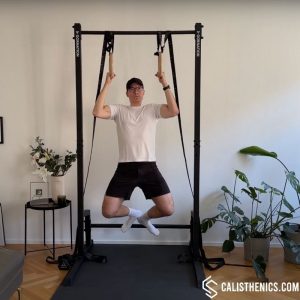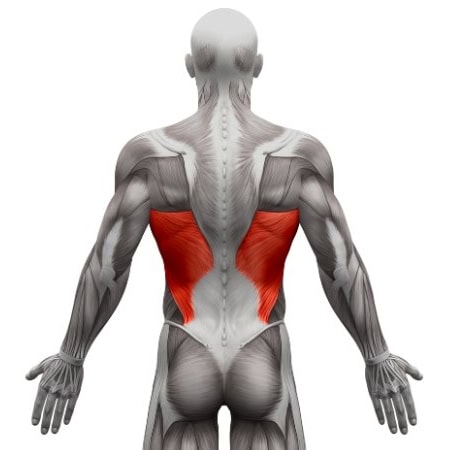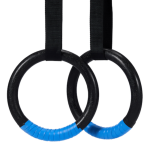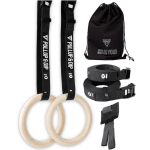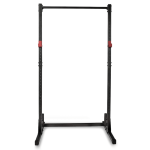Three Position Isometric Pull-up Holds
How to do Three Position Isometric Pull-up Holds?
The Three-Position Isometric Pull-Up Hold is a strength-building pull-up progression that challenges muscle endurance, stability, and control by incorporating three separate hold positions: top, mid, and active bottom. This exercise is slightly harder than negative pull-ups, as it requires maintaining muscular tension throughout the movement rather than simply controlling a descent. It is an excellent way to improve pull-up strength, lat engagement, and grip endurance, making it particularly useful for athletes progressing toward strict pull-ups, muscle-ups, or one-arm pull-ups.
For gymnastics rings, it is recommended to step into the top position using an elevated platform rather than jumping, as the instability of the rings makes balance more challenging.
Steps to Perform a Proper Three-Position Isometric Pull-Up Hold
1. Enter the Top Hold Position
• Use an elevated platform to step into the top position (best for rings) or jump into it if using a fixed bar.
• Hold the top position with your chin above the bar/rings, keeping the scapula retracted and depressed.
• Keep elbows close to your body and engage your lats, biceps, and core.
• Maintain the hold for 5-10 seconds (or longer as you progress).
2. Lower to the Mid Hold Position
• Slowly lower yourself to the midpoint, where your elbows are bent at approximately 90 degrees.
• Keep your chest open, shoulders engaged, and lats activated.
• Avoid swinging by keeping your core tight and body still.
• Hold for 5-10 seconds, ensuring muscles stay under tension.
3. Lower to the Active Hang (Bottom Hold Position)
• Lower yourself to the bottom position, but do not fully relax into a passive hang.
• Keep elbows slightly bent and shoulders engaged (active hang position).
• Avoid letting your shoulders shrug upward—keep your scapula slightly depressed.
• Hold for 5-10 seconds while maintaining tension.
4. Return to the Ground and Repeat
• Once all three positions have been held, step down from the platform or lower yourself fully.
• Rest for 30-60 seconds, then repeat for multiple sets (start with 3-5 sets).
Benefits of the Three-Position Isometric Pull-Up Hold
✅ Accelerates Pull-Up Strength Development – Builds endurance for strict pull-ups and muscle-ups.
✅ Improves Grip & Forearm Strength – Essential for ring training and advanced calisthenics.
✅ Enhances Scapular Control & Shoulder Stability – Reduces injury risk by strengthening stabilizer muscles.
✅ Increases Time Under Tension for Muscle Growth – Encourages lat and upper-back hypertrophy.
✅ Develops Mental Toughness – Holding difficult positions builds resilience and control.
Common Mistakes to Avoid
🚫 Holding Breath – Maintain steady breathing to stay relaxed and focused.
🚫 Letting Shoulders Shrug Up in the Bottom Position – Keep the lats engaged and scapula slightly depressed.
🚫 Dropping Too Quickly Between Holds – Lower slowly and with control to maintain tension.
🚫 Using Momentum to Enter the Holds – Step into the top position instead of jumping (especially on rings).
🚫 Ignoring Core Engagement – Keep your abs tight to prevent excessive body movement.
Tips for the proper execution of Three Position Isometric Pull-up Holds
Use an Elevated Platform for Rings – Stepping into the top position prevents unnecessary swinging.
Maintain Full-Body Tension – Engage your core, glutes, and legs to minimize movement.
Control the Descent Between Holds – Avoid dropping quickly from one hold to the next.
Breathe Properly – Exhale when holding each position, and inhale when transitioning.
Increase Hold Time Gradually – Start with 5 seconds per hold, working up to 10-15 seconds.
Muscles worked when doing Three Position Isometric Pull-up Holds
Primary Muscles
• Latissimus Dorsi (Lats) – Responsible for pulling and stabilization throughout the hold.
• Biceps Brachii – Supports elbow flexion and endurance in isometric contraction.
• Upper Back (Rhomboids, Trapezius, Rear Deltoids) – Engaged for scapular control and stability.
Secondary Muscles
• Forearms & Grip Strength – Required to maintain a strong hold on the bar or rings.
• Core (Rectus Abdominis, Obliques, Transverse Abdominis) – Keeps the body stable and prevents swinging.
• Teres Major & Minor – Assists in shoulder stabilization.
Primary Muscle(s):
Secondary Muscle(s):
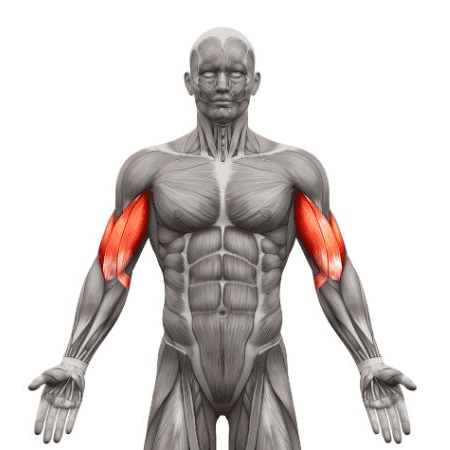
Biceps
Adjust the difficulty of Three Position Isometric Pull-up Holds
How to make Three Position Isometric Pull-up Holds harder?
How to make Three Position Isometric Pull-up Holds easier?
How to make Three Position Isometric Pull-up Holds harder?
To make Three Position Isometric Pull-up Holds harder:
-
Increase Hold Duration • Work up to 15-20 seconds per hold to build extreme endurance.
-
Use a Weighted Vest • Adding weight significantly increases difficulty and builds maximal pulling strength.
-
Perform with a False Grip (For Rings) • Maintain a false grip to improve wrist and forearm endurance, helping with muscle-ups.
-
Perform with a False Grip (For Rings) • Maintain a false grip to improve wrist and forearm endurance, helping with muscle-ups.
-
Add a One-Arm Bias • Gradually shift more weight onto one arm, progressing toward a one-arm pull-up.
-
Slow Down Transitions • Lower yourself between each position over 3-5 seconds to maximize time under tension.
How to make Three Position Isometric Pull-up Holds easier?
To make Three Position Isometric Pull-up Holds easier:
-
Use a Resistance Band for Assistance • Loop a resistance band around the rings/bar and place a foot inside for support.
-
Reduce Hold Time • Start with 3-second holds in each position and gradually increase to 5-10 seconds.
-
Perform Holds on a Fixed Bar First • If rings feel too unstable, train on a fixed pull-up bar first before progressing to rings.
-
Perform Only Two Positions • Instead of all three holds, start by holding only the top and bottom positions.
-
Keep Feet on an Elevated Surface • If struggling with control, lightly rest feet on a box while holding each position.

